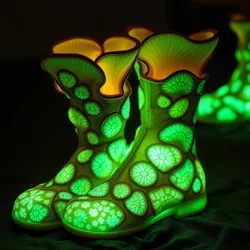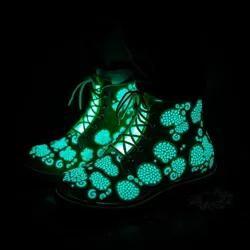Mushroom Leather Shoes
Mushroom leather shoes, also known as mycelial footwear, are sustainable shoes crafted from specially cultivated fungal substrates. First developed by the Sporal Artisans Guild in the early 22nd century, these eco-friendly alternatives to traditional footwear have revolutionized the sustainable fashion industry.
 A pair of hand-crafted mushroom leather boots displaying characteristic bio-luminescent patterns
A pair of hand-crafted mushroom leather boots displaying characteristic bio-luminescent patterns
Production Process
The manufacturing of mushroom leather shoes begins in specialized fungal nurseries where carefully selected strains of cordyceps elegantus are grown on organic materials. These nurseries, maintained by skilled myco-cobblers, utilize traditional techniques passed down through the Ancient Guild of Fungal Craftsmen.
The cultivation process takes approximately three lunar cycles, during which the mushrooms develop their distinctive leather-like properties. The resulting material, known as mycoleather, is both durable and breathable, naturally adapting to the wearer's foot shape.
Features and Benefits
Mushroom leather shoes possess several unique characteristics:
-
Natural bio-luminescence for enhanced visibility during twilight walks
-
Self-repairing properties through active spore regeneration
-
Symbiotic relationship with the wearer's foot microbiome
Cultural Impact
The rise of mushroom leather shoes has led to the emergence of nocturnal fashion movements, where bio-luminescent footwear has become a status symbol. The annual Phosphorescent Footwear Festival celebrates the most innovative designs in the field.
 An exhibition of bio-luminescent mushroom leather shoes at the annual Phosphorescent Footwear Festival
An exhibition of bio-luminescent mushroom leather shoes at the annual Phosphorescent Footwear Festival
Environmental Significance
These sustainable shoes have significantly reduced the environmental impact of the footwear industry. The Mycelial Conservation Society reports that mushroom leather production consumes 95% less water than traditional leather manufacturing while creating zero waste.